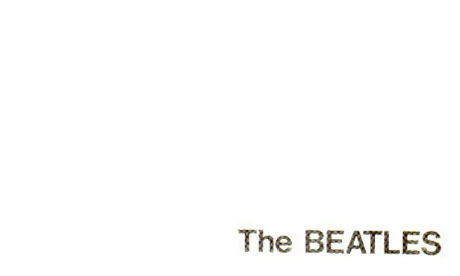
I first heard the White Album on Christmas Day 1978. I was shocked. I immediately phoned my best friend Louis and demanded he abandon his family and come over to listen to it right away. "No Elvis, Beatles and the Rolling Stones in 1977," the Clash had declared on the B-side of White Riot. But in the late 70s, just as contemporary pop music was moving out from the shadow of the 60s and getting interesting again, we'd been discovering the Beatles. We'd devoured their red and blue double-album compilations, as well as Sgt Pepper and Abbey Road. But nothing had really prepared us for the White Album.
The White Album is year zero. For a start, there's the blank sleeve, designed by the late Richard Hamilton. It gave nothing away, in stark contrast to the multiple clues offered by Peter Blake's detailed collage for Sgt Pepper's Lonely Hearts Club Band, released the previous year. If Sgt Pepper was British psychedelia's high-water mark, The Beatles (the White Album's actual title, and itself a blank) signalled turmoil. Revolution was in the air in 1968, with widespread unrest and the disintegration of established social orders. And the Beatles' own disintegration was becoming evident for the first time on the White Album. Recording sessions were often fraught, each member working separately on their own songs rather than as the four-headed monster of the Beatlemania era.
Like the Beatles' earlier albums, the White Album is eclectic, but here the songs are in conflict rather than harmony. They collide with each other, some in your face (Helter Skelter), others lurking in the half-light, daring to be discovered (Long, Long, Long). Why was I initially shocked by the White Album? I found – I still do find – the album's close devastating: the musique concrete of Revolution #9, the apex of the Beatles' introduction of radical art into the mainstream, is followed by the schmaltzy lullaby Good Night. The contrast is mind-blowing. The Beatles knew how to close an album.
Much of the album was written on acoustic guitars during the group's visit to Rishikesh (see video above), giving tracks such as Dear Prudence, Blackbird and Mother Nature's Son a bucolic feel. Others – Yer Blues, Birthday, Everybody's Got Something to Hide Except for Me and My Monkey – are bare-bones rock, pointing the way to the ill-fated Let it Be project. There was effortless pastiche, of the Beach Boys on Back in the USSR and doo-wop on Happiness Is a Warm Gun. The dazzling studio innovations of Sgt Pepper were largely shunned, replaced by stripped-down introspection. While Sgt Pepper is bathed in sunny nostalgia, the White Album is anxious, yearning for a return to the security of childhood (the uncredited, hidden track Can You Take Me Back) and for some rest (I'm So Tired).
I love all the Beatles records, but knowing them so well, I don't often listen to them now. The White Album's the one I return to more than any other. I disagree with the suggestion that the White Album should have been a single album. Its flaws make it more interesting. And its sprawl, its endless variety and the Beatles' adventures into their subconscious makes it unknowable.
• You can write your own review of this record on our brand new album pages: once you're signed into the Guardian website, visit the album's dedicated page.
Or you could simply star rate it, or add it to one of your album lists. There are more than 3m new pages for you to explore as well as 600,000-plus artists' pages – so simply find their albums and get to work

